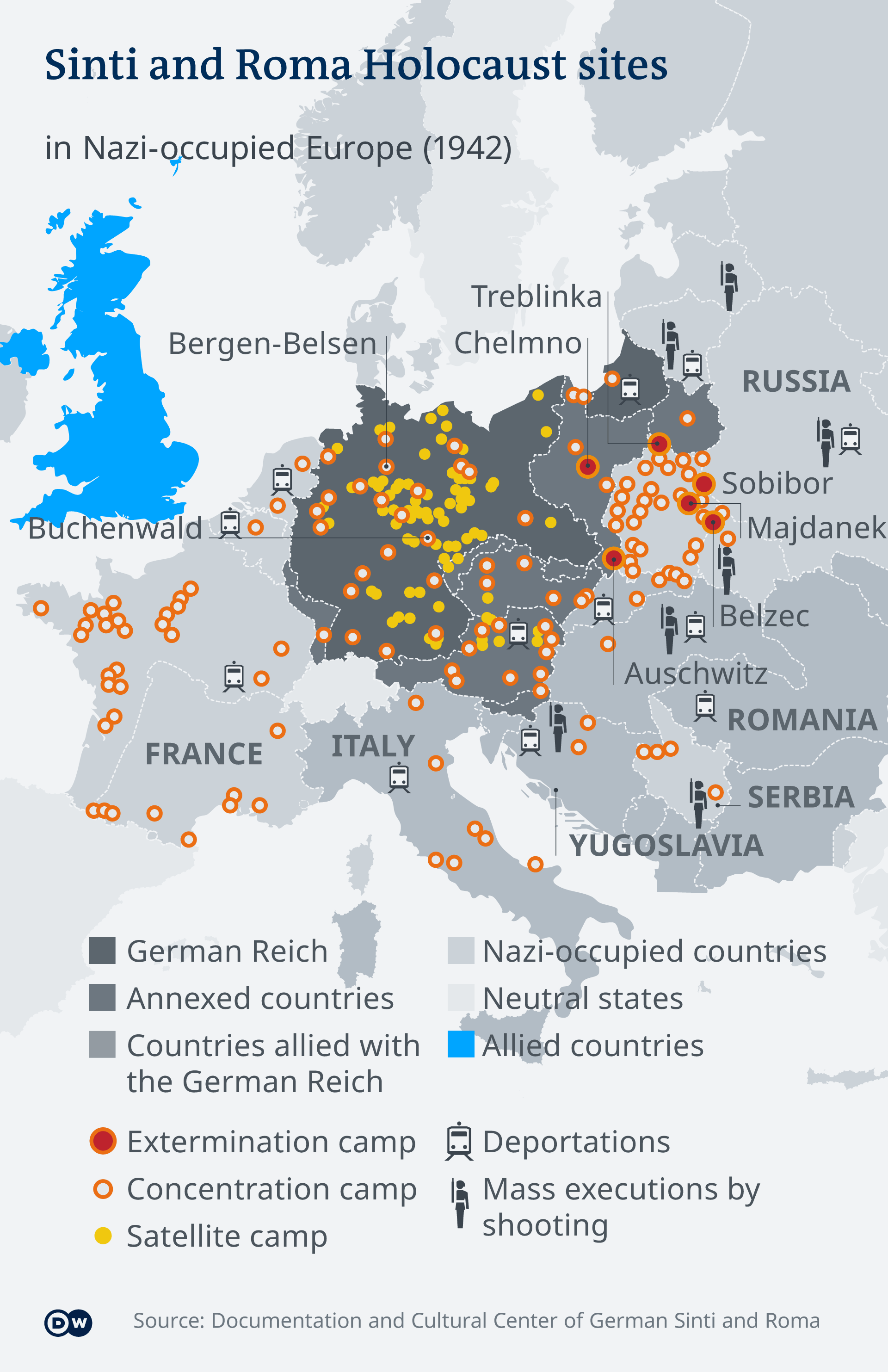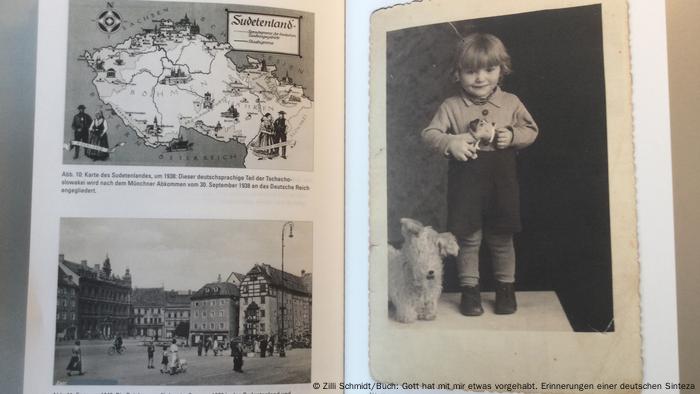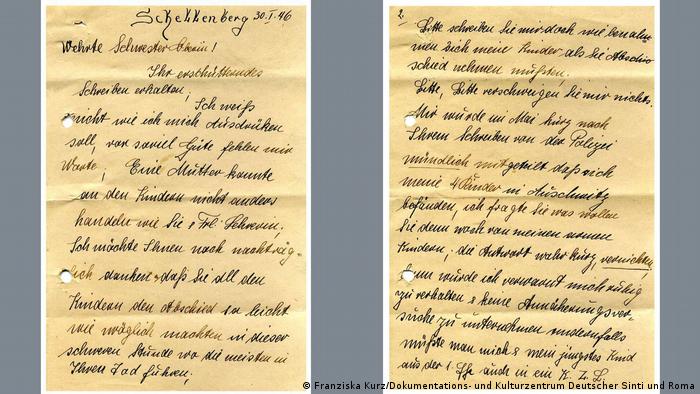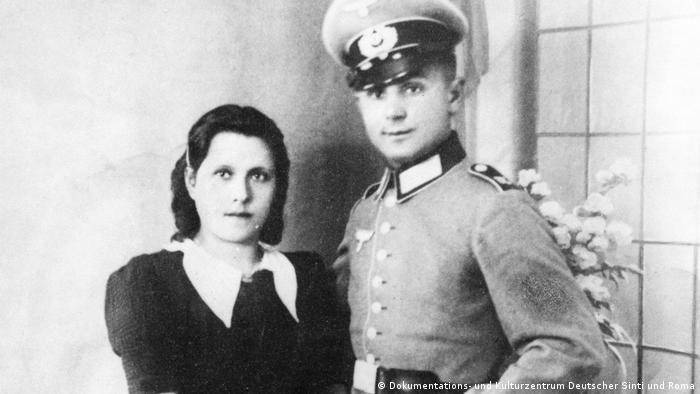On August 2, 1944, 4,300 Sinti and Roma were killed in the gas chambers of the Auschwitz-Birkenau death camp. Genocide survivors described the horrors. To this day, many of their descendants are refused compensation.

Before the Holocaust: The German-Sinti Bamberger family in the 1930s
"Dear Banetla, I have to tell you that my two youngest children have died." Those words were written by Margarete Bamberger in a 1943 letter to her sister in Berlin. It was smuggled out of what was known as the "gypsy camp" at the Auschwitz-Birkenau concentration camp. Margarete, her husband Willi and their children were all detained at the death camp. Margarete and Willi survived the ordeal. Their children did not.
Bamberger had desperately implored relatives to send parcels containing cod liver oil, cough syrup, vitamin C, washing powder and anything that could be used to combat scabies. "Whatever it is, and however small, it might help us here," she wrote. She also used the Romani language to send a hidden message, expressing the full horror of their situation: "Special greetings from Baro Nasslepin, Elenta and Marepin" — code for the three horrors "disease, misery and murder."

A memorial stone at the Auschwitz-Birkenau camp marks the genocide: 'Here lie their ashes, may their souls rest in peace'
The remains of this letter, as well as 60 other testimonies, can be studied in the original version in German, English and Romani at the Voices of the Victims portal of the RomArchive. Coordinated by historian Karola Fings, scholars from across Europe have collected letters and statements from persecuted minorities from 20 countries: Belarus, Belgium, Bosnia-Herzegovina, Germany, Estonia, France, Italy, Croatia, Latvia, the Netherlands, Austria, Poland, Romania, Russia, Switzerland, Serbia, Slovakia, Czech Republic, Ukraine and Hungary.
Fings, of the Research Center on Antiziganism at the University of Heidelberg, told DW that what makes this resource so special is that the focus is not on the perpetrators. Instead, she said, the voices of the Sinti and Roma themselves are heard. The texts date from the time of the persecution itself, or from the period just a short while later when the victims began to bear witness to the crimes committed against their minority and early attempts were undertaken to bring the perpetrators to justice.

Like Margarete Bamberger's children, the vast majority of the prisoners killed at the Auschwitz-Birkenau death camp died of hunger, disease or unbridled violence. The night of August 2, 1944, was the "horrific high point" of the racially motivated persecution of the Sinti and Roma, said Fings.
The SS liquidated the "family camp" at Auschwitz-Birkenau, driving 4,300 screaming and wailing people to their deaths. It was truly a day of horror in the Romani Holocaust, known also as the Porajmos. In 2015, the European Parliament declared August 2 as Roma Holocaust Memorial Day for Sinti and Roma.
However, because of the COVID-19 pandemic, this year the day will largely be commemorated in digital ceremonies.
Among those gassed to death on that terrible night in 1944 was the daughter of Zilli Schmidt: 4-year-old Gretel died together with her grandparents, her aunt and her six cousins. Like other inmates deemed fit to work, Gretel's mother had been transported elsewhere just a short while earlier. She had tried to escape from the train that was to carry her away and run to her family. But notorious SS doctor Josef Mengele slapped her about the head and forced her back into the wagon: "He saved my life, but he did me no service," remembered Schmidt.

Zilli Schmidt's most precious belonging was this photo of her daughter, Gretel
Mano Höllenreiner, 10, from Munich was among those who had, together with his parents, been transported to the Ravensbrück concentration camp. But he lost many relatives in Auschwitz: cousins with their children, aunts and "my poor grandmother who I loved so much — also gassed."
From a Catholic children's home to Auschwitz
Franziska Kurz lost four of her children: Otto, Sonja, Albert and Thomas were taken away and kept in a children's home before they were later deported.
In 1946, Kurz wrote to the mother superior of the St. Josefspflege Catholic children's home in southern Germany. The police had told her that "my four children were in Auschwitz." So, I asked them: "What on Earth do you still want from my poor children? The answer was short: "extermination."
She had been warned to "keep quiet." Otherwise, Kurz was told, both she and her youngest child, Maria, would be sent to a concentration camp.
Otto, Sonja, Thomas and Albert were all murdered at Auschwitz; the Catholic Church did not protect them. Thirty-nine Sinti children passed through the St. Josefspflege children's home, and only four survived.
It wasn't the only case of its kind. In May 1943, as deportation to Auschwitz and forced sterilization threatened, Oskar Rose wrote the following to the archbishop of Breslau: "If our Catholic Church fails to give us its protection, we shall be exposed to measures that, both morally and legally, make a mockery of all forms of humanity." He was at pains to point out that it was not merely a threat to the well-being of a few isolated families, "but to 14,000 members of the Roman Catholic Church."

Franziska Kurz wrote a letter asking about the fate of her four children, who had been deported to Auschwitz
However, this appeal and others like it fell on deaf ears. By way of contrast, said Karola Fings, there were examples from occupied territories in Yugoslavia and the Soviet Union, "where Muslim communities protected Roma neighbors, helping them to avoid deportation."
Genocide in Europe: Cruelly systematic, horrifically spontaneous
Wherever in Europe the Nazis gained ground, Sinti and Roma were persecuted and forced to fight for their lives. Many were murdered, in camps, or in mass shootings. "It all depended on local occupation policies and who the local proxies were," said Fings.
In German-occupied Poland, there were the death camps. However, there were also an estimated 180 other locations where massacres are known to have taken place. And when it comes to the Soviet Union or Yugoslavia, "most of the victims were not murdered in camps but wherever the killing happened to take place — on the spot."
In occupied Bohemia and Moravia — today's Czech Republic — Sinti and Roma were detained at the Lety and Hodonin camps before being deported to Auschwitz. In Croatia, Jasenovac "was a particularly horrific camp, where many were beaten to death."
Croatia: 'We were shipped here to die'
Josip Joka Nikolic was a musician, who lived his early years until 1942 in the small settlement of Predavac. Then the police and other men from the pro-fascist Croatian Ustasa movement that was loyal to the Independent State of Croatia (NDH) broke into the house and took his and other Roma families away.
It was said that they were being resettled, "from the oldest man to the youngest child." His wife, their 8-month-old daughter, parents, brothers and their families were all taken away in cattle trucks to the Jasenovac concentration camp.
Nikolic realized that they had been "brought there to die." He was brutally separated from his wife and child and led away with the other men to be executed. Somehow, though, he managed to escape and joined the resistance fighters, the partisans. But his whole family was killed at Jasenovac. Nikolic was a witness in a 1952 trial against the NDH interior minister, who however fled to the United States.
Serbia: Solving 'both the Jewish and the Gypsy question'
At the end of October 1941, reports Milena Stankovic, the Germans surrounded her Belgrade district. "Two agents and two gendarmes from the Serbian state security forces burst into our apartment," she remembered. Her husband and one brother were employed by the city authorities. Their stepson was a musician, and another brother was a laborer. All of them had children, and all had Serb citizenship. The men were taken away to a camp, where up to 1,500 Roma were interned. A few days later they were shot and killed outside the town.
Just over a month after the killing of the men, the Romnja — Romani women — were forced onto trucks together with their children and taken away to a concentration camp. The cold was extreme, as was the hunger. "My youngest child died because I could no longer breastfeed," reported Natalija Mirkovic.

The commemoration book at Auschwitz lists the names of almost 21,000 individuals deported from all across Europe
Anyone who could prove that they had a permanent place of residence was later allowed to go free. Some spoke out on behalf of their neighbors, and some were probably killed together with Jewish detainees. The head of the German military administration in Serbia boasted in August 1942 that Serbia was the only country in which both the "Jewish and the Gypsy questions" had been "solved."
In February 1945, Angela Lakatos was in the late stages of pregnancy. Her contractions were painful. Suddenly, between 30 and 40 gendarmes arrived in her Roma settlement in western Hungary, determined to drive the Roma away. When Lakatos asked for help, one of the gendarmes answered: "Go to hell!" 120 Roma were forced inside a barn, and pleas for water were met with blows.
First, the men were taken away. Then the younger women. Another highly pregnant woman couldn't walk at all. One gendarme beat her. The next "used a machine gun to shoot the child out of her stomach." Lakatos and the others were driven into a pit: "I saw my father lying there dead. And both of my brothers. I myself half jumped into the pit, half fell."
She pulled her scarf over her head "to avoid seeing what was about to happen. But then it began to rain bullets." She was hit eight times: in her arm, her leg, her stomach. Others fell on top of her, their bodies catching the bullets. It was hours before she climbed out of the pit.
Lakatos survived, but she was severely wounded. She lost her whole family and her unborn child. After the war, she was a witness against the commander of the operation, Jozsef Pinter. She emphasized how thorough and systematic the operation had been. Pinter was found guilty of war crimes and in September 1948 he was executed — one of the very few perpetrators brought to justice for involvement in the killing of the Roma people.
Russia: Stripped naked and thrown into a pit alive
Lidija Nikiticna Krylova tells of a "nightmarish crime" committed by "German invaders in the village of Aleksandrovka on peace-loving Soviet citizens — members of a Roma collective farm." In April 1942, a German officer had a list that he used to call out the names of villagers one by one. Non-Roma were sent home.
Roma families were then forced to undress before being driven with whips "like cattle" to the edge of a pit. The older children were shot before the eyes of their mothers. Then babies were torn from their arms and thrown into the pit.
"Not only children were thrown alive into the pit," reported Nikiticna Krylova. "The Germans also shoved a sick old woman carried by her daughters into the pit. Krylova and others only escaped death at the very last moment. They later gave their testimony in Soviet investigations into Nazi war crimes.
Roma in Eastern Europe shut out from compensation
In many countries today there is still very little awareness that Sinti and Roma were victims of systematic genocide, said Karola Fings. She believes the full extent of the murderous violence will only become clear with a wider European perspective.
In response, researchers are working on an encyclopedia of Nazi genocide — a project that the German Foreign Office is backing with €1.2 million ($1.4 million).
Watch video02:11 Sinti, Roma memorial in Berlin threatened
In Germany, the genocide was largely ignored for decades. Members of the police continued to employ racist methods, using Nazis files in investigations and blocking acceptance that Sinti and Roma have been gravely persecuted. That, in turn, led to further trauma for survivors: trauma that has extended into the second and third generations, said Fings.
The historian was a member of the German government's Independent Commission on Antigypsyism which recently issued its final report. Alongside clear recognition of the genocide committed against Sinti and Roma and further investigation through the mediation of a truth commission, Fings said there must be material compensation — and not just in Germany.
"This also applies to those living in other countries, especially in Eastern Europe who after 1945 were completely shut out from compensation," she said.
The commission also said that, as is the case with Jewish victims of Nazi persecution and their descendants, Germany must also take responsibility for ensuring "that Roma and Romnja are recognized as an especially marginalized and vulnerable group."
This article has been translated from German
REMEMBERING NAZI GENOCIDE OF SINTI AND ROMAServing the fatherlandMany German Sinti fought for Germany not only in the First World War but also in the Wehrmacht from 1939 on. In 1941 the German high command ordered all "Gypsies and Gypsy half-breeds" to be dismissed from active military service for "racial-political reasons." Alfons Lampert and his wife Elsa were then deported to Auschwitz, where they were killed.

No comments:
Post a Comment